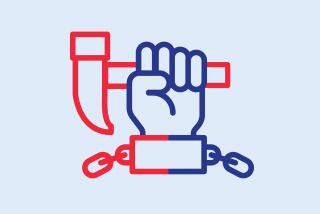Editorial: An end to shackling prisoners in federal court
It’s obvious that placing a criminal defendant in handcuffs and leg shackles runs the risk of prejudicing a jury. But even when only a judge is present, a policy of shackling a defendant violates his dignity, mocks the presumption of innocence and offends what the Supreme Court has called the “dignity and decorum of judicial proceedings that the judge is seeking to uphold.”
That’s why the U.S. 9th Circuit Court of Appeals was right this week to order an end to routine shackling of prisoners in the federal district court based in San Diego.
Before the ruling came down, the judges of the U.S. District Court for the Southern District of California had ordered that suspects appear in court for arraignments and other proceedings in “full shackle restraints.” That policy, recommended by the U.S. Marshals Service, meant that prisoners were restrained by handcuffs and leg shackles connected to a belly band by a 15-inch chain. (Some individual judges opted out of the full-restraint policy.)
Writing for the appeals court, Circuit Judge Mary M. Schroeder rejected the notion that the shackling policy was justified by staffing shortages in the Marshals Service or by the fact that on two occasions one prisoner attacked another. She concluded that the full-restraint policy “cannot rest primarily on the economic strain of the jailer to provide adequate safeguards.”
This week’s decision didn’t prohibit all shackling, and it drew a distinction between the full-restraint policy at issue in this case and the practice of placing defendants in leg shackles only, a policy it upheld in a 2007 case involving the Edward R. Roybal courthouse in downtown Los Angeles.
Still, the court’s general criticism of shackling — and its rejection of restraint as a cost-cutting device — ought to encourage judges in all federal courts, not just those in California or the 9th Circuit, to reflect on whether prisoners are being unnecessarily restrained.
In rare cases, of course, restraints will be necessary because of the violent behavior of particular defendants. But routinely shackling or handcuffing defendants who are presumed innocent insults their dignity as well as the court’s. And it can have painful human consequences: The lawyer who challenged the shackling noted that some detainees had asked relatives not to come to court because they didn’t want to be seen in chains.
Judges, who have the final word on security arrangements in their courtrooms, shouldn’t adopt a policy of “better safe than sorry,” especially in light of the fact that defendants in federal court are often accused of nonviolent crimes. The appeals court decision will force them to ensure that shackling prisoners is the last, not the first, resort.
Follow the Opinion section on Twitter @latimesopinion and Facebook
More to Read
A cure for the common opinion
Get thought-provoking perspectives with our weekly newsletter.
You may occasionally receive promotional content from the Los Angeles Times.










